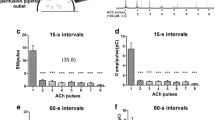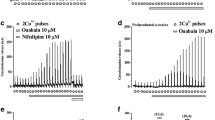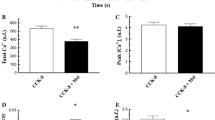Summary
Cytoplasmic Ca2+ is regarded as an intracellular messenger for acetylcholine- and cholecystokinin (CCK)-stimulated pancreatic enzyme secretion. We investigated in the in vitro model of isolated rat pancreatic acini whether or not Ca2+-channel blockers are able to inhibit Ca2+-mediated enzyme secretion. Isolated rat pancreatic acini were prepared via collagenase digestion. The effect of various Ca2+-channel blockers on amylase secretion stimulated by various secretagogues was monitored. Verapamil, but not nitrendipine, dose-dependently reduced CCK8- and carbachol-stimulated enzyme secretion. Higher doses of either CCK8 or carbachol could not reverse the inhibition caused by verapamil. Amylase secretion stimulated by the ionophore A23817 was not altered by verapamil. Verapamil augmented enzyme secretion stimulated by secretagogues which work through cAMP as second messenger.3H-N-methylscopolamine- and125I-Bolton-Hunter-CCK8-binding to pancreatic acini was dose-dependently inhibited by verapamil, but the inhibition curves did not parallel the inhibition curves with unlabeled receptor agonists. Thus, the impairment of exocrine pancreatic amylase secretion by verapamil is probably not due to its known “Ca2+-channel” blocking abilities in other tissues but is rather caused by noncompetitive effects on the level of muscarinic receptors and receptors for CCK.
Similar content being viewed by others
References
Barone FC, White RF, Ormsbee HS III, Wasserman MA (1986) Effects of calcium channel entry blockers, nifedipine and nivaldipine, on colonic motor activity. J Pharmacol Exp Ther 237:99–106
Barreras RF (1973) Calcium and gastric secretion. Gastroenterology 64:1168–1184
Berridge MJ (1983) Rapid accumulation of inositol trisphosphate reveals that agonists hydrolyse polyphosphoinositides instead of phosphotidylinositol. Biochem J 212:849–858
Bouclier M, Speeding M (1985) Differential effects of calcium channel antagonists on histamine and pentagastrin-stimulated gastric acid secretion in the rat. Agents Actions 16:491–495
Bradford M (1976) A rapid and sensitive method for the quantitation of microgram quantities of protein utilizing the principle of protein-dye binding. Anal Biochem 72:248–254
Braunwald E (1982) Mechanism of action of calcium channel-blocking agents. N Engl J Med 307:1618–1627
Brodie MJ, Ganguli PC, Fine A, Thompson TJ (1977) Effects of oral calcium gluconate on gastric acid secretion and serum gastrin secretion in man. Gut 18:111–114
Burgess GM, Godfrey PP, McKinney JS, Berridge MJ, Irvine RF, Putney JW, Jr (1984) The second messenger linking receptor activation of internal Ca2+ release in liver. Nature 307:63–66
Burns GP, Gersten M, Bank S, Stein TA, Zimmerman HM (1986) The effect of verapamil on pancreatic exocrine secretion. Surgery 99:474–480
Cavero I, Speeding M (1983) Calcium antagonist: A class of drugs with a bright future, part I: Cellular calcium homeostasis and calcium as a coupling messenger. Life Sci 33:2571–2581
Douglas WW, Rubin RP (1963) Mechanism of catecholamine release from the adrenal medulla and the role of Ca in the stimulus-secretion coupling. J Physiol (Lond) 167:288–310
Fleckenstein A (1977) Specific pharmacology of calcium in myocardium, cardiac pacemakers, and vascular smooth muscle. Annu Rev Pharmacol Toxicol 17:149–166
Gardner JD (1979) Regulation of pancreatic exocrine function in vitro: Initial steps in the actions of secretagogues. Ann Rev Physiol 41:55–66
Gardner JD, Jensen RT (1982) Receptor modulation of calcium and cyclic AMP: Differences in coupling to specific hormone-receptor complexes in cells responsive to several hormones. In: Kohn LD (ed) Hormone receptors. Wiley, Chichester, pp 277–308
Gardner JD, Jensen RT (1983) Gastrointestinal peptides: The basis of action at the cellular level. Recent Prog Horm Res 39:211–243
Grimm G, Salem G, Prager-Petz J, Pils P, Gloeckler M, Sadowsky J, Pointer H (1985) Influence of verapamil on gastric acid secretion and gastrin release in dogs. Digestion 32:282–287
Hahne WF, Jensen RT, Lemp GF, Gardner JD (1981) Proglumide and benzotript: Members of a different class of cholecystokinin receptor antagonists. Proc Natl Acad Sci USA 78:6304–6308
Hay DWP, Wadsworth RM (1982) Local anesthetic activity of organic calcium antagonists: Relevance to their actions on smooth muscle. Eur J Pharmacol 77:221–228
Jensen RT, Lemp GF, Gardner JD (1980) Interaction of cholecystokinin with specific membrane receptors on pancreatic acinar cells. Proc Natl Acad Sci USA 77:2079–2083
Katz AM, Hager WD, Messineo FC, Pappano AJ (1985) Cellular actions and pharmacology of the calcium channel blocking drugs. Am J Med 79:2–10
Kraynack BJ, Lawson NW, Gintautas J (1982) Local anesthetic effect of verapamil in vitro. Reg Anaesth 7:114–117
Niederau C, Hellmann A, Sonnenberg A, Erckenbrecht J (1985) Effects of verapamil on exocrine pancreatic secretion in man. Dig Dis Sci 30:72–77
Rauscher E, Neumann U, Schaich E, von Bülow S, Wahlefeld AW (1985) Optimized conditions for determining activity concentration of alpha-amylase in serum, with 1,4-alpha-d-4-Nitrophenylmaltoheptaoside as substrate. Clin Chem 31:14–19
Streb H, Irvine RF, Berridge MJ, Schulz I (1983) Release of Ca2+ from a nonmitochondrial intracellular store in pancreatic acinar cells by inositol-1,4,5-triphosphate. Nature 306:67–68
Williams JA, Korc M, Dormer RL (1978) Action of secretagogues on a new preparation of functionally intact, isolated pancreatic acini. Am J Physiol 235:E 517–524
Williams JA (1980) Regulation of pancreatic acinar cell function by intracellular calcium. Am J Physiol 238:G 269–279
Williams JA, Bailey AC, Preissler M, Goldfine ID (1982) Insulin regulation of sugar transport in isolated pancreatic acini from diabetic mice. Diabetes 31:674–682
Williams JA, Hootman SR (1986) Stimulus-secretion coupling in pancreatic acinar cells. In: Go VLW, Gardner JD, Brooks FP, Lebenthal E, DiMagno EP, Scheele G (eds) The exocrine pancreas. Raven Press, New York, pp 123–139
Zinner MJ, McFadden D, Sherlock D, Jaffe BM (1986) Verapamil reversal of serotonininduced jejunal secretion of water and electrolytes in awake dogs. Gastroenterology 90:515–519
Author information
Authors and Affiliations
Additional information
Financially supported by a grant from the Deutsche Forschungsgemeinschaft MO 372/2-2
Rights and permissions
About this article
Cite this article
Mössner, J., Schwarz, J. & Fischbach, W. Influence of “calcium2+-channel blockers” on exocrine pancreatic secretion by isolated rat acini. Res. Exp. Med. 188, 255–265 (1988). https://doi.org/10.1007/BF01852274
Received:
Accepted:
Issue Date:
DOI: https://doi.org/10.1007/BF01852274




